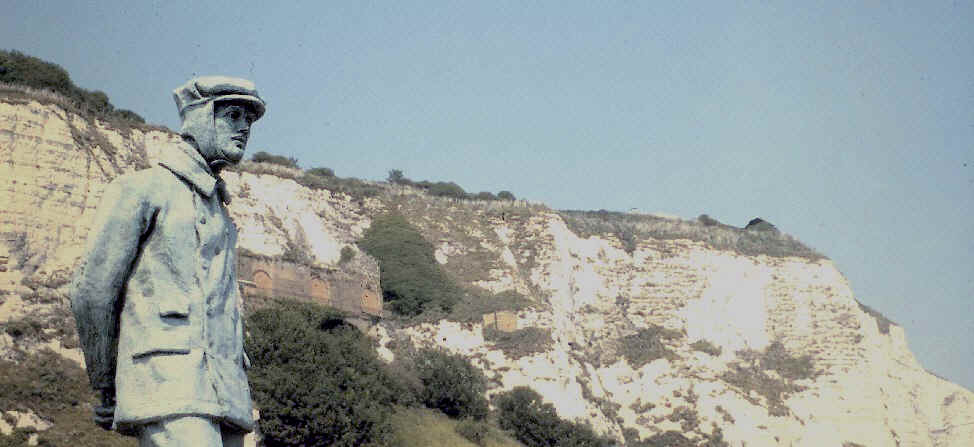
Image du Jours -- Early Aviation
Next Early Aviation Image du Jour
About Early Aviation -- #6 of 7.

Rolls looking across the English Channel from Dover (K.Cashion)
CHARLES ROLLS
We often remember the first to accomplish something and the second accomplishment seems of little consequence, sometimes not even reported. The first aviator to fly the English Channel was Louis Bleriot. The second was another Frenchman, Count DeLesseps. (Who?) Aviation enthusiasts in England did not like it that an Englishman had not managed such a spectacular flight. After all, it was the English Channel, not the French Channel.An Englishman stepped forward on June 2, 1910. A tall Englishman. Charles Rolls, at 6'-5", took off from England in his biplane, a Wright Flyer, bound for France. But rather than land in France, he turned his flying machine around and flew back to England. This took a little over an hour and a half. Besides the gratitude of the nation and the awe of his fellow aeronautists, Rolls received a gold medal from the Royal Aero Club; courtesy of the King and Queen.
Charles Rolls, a pioneer in aviation, was also an early supporter of the automobile. He was particularly fascinated by their engines.
He was born in 1877 into a family with a tradition of money and influence. Both of these are important when developing new technologies. He was educated at two of the best English colleges and he enjoyed the rich life of Edwardian England.
When only 18, he was driving the third auto in Wales. He disobeyed most of the archaic laws of auto travel...such as having someone walk in front of his auto and wave a red flag. He routinely exceeded the 4 mph speed limit. He, and driving friends, en masse, staged a driving demonstration on public roads. This forced the authorities to raise the speed limit to 12 mph. This might seem slow but this was a 300% increase.
When he was 23, he won a thousand-mile auto race, and later, he started one of the first auto dealerships selling expensive French autos.
He was a young man with a realistic vision of the future. He saw the way to the sky would first be by balloon so he became an accomplished balloonist and made nearly 200 ascents; he crossed the channel several times in balloons.
In 1903, he was instrumental in establishing the Royal Aero Club. The same year the aero club was formed, he received his flying license; the second in Britain. Also that year, he won the Gordon Bennett Gold Medal for the longest single flight.
Three years later, he and Frederick Henry Royce founded the Rolls-Royce motor car company. Royce provided the engineering expertise, and Rolls, the financing and good business sense. In only a year, their cars were winning awards for reliability.
On July 12, 1910, Charles Rolls was at a flying exhibition near the English Channel. He was flying his Wright biplane and one event was a spot landing contest. A landing mark was placed in front of the main grandstands. He took off and gained the required altitude. Then he shut off the engine and started gliding in large circles. At about 100' altitude, the tail plane of the biplane snapped off. With this loss of pitch control, the airframe changed attitude very quickly, and the wings buckled. Rolls was caught inside the twisted wire, splintered wood, and fabric. He crashed directly in front of the grandstand. It was difficult removing him from the wreckage. The attending physician said he died almost immediately from a fractured skull. He had died only a month after his round-trip flight across the channel. He had accomplished a lot in his 33 years.
Only 29 years later, brave young men like Rolls were defending England against the German air force. The French Air Force had not lasted very long.
The principal British aircraft engine during this war was one bearing Charles Rolls’ name. The Rolls-Royce Merlin engine was mounted in Hurricanes, Spitfires, Mosquitoes, Lancasters, Halifaxes, Whitleys, Wellingtons, Beaufighters, plus other aircraft, and they help prevent Germany from invading Britain.
And later, the same engine powered the P-51 Mustangs as they escorted bombers on their long missions to Berlin.
.Ken Cashion
Next Early Aviation Image du Jour